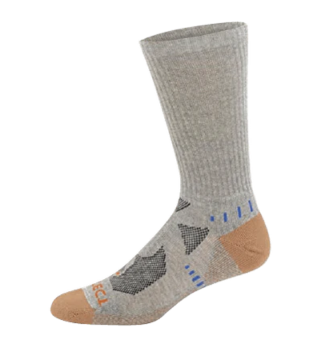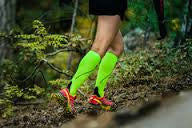
Compression socks are tight-fitting garments that improve circulation by applying pressure to the legs and feet. They are available over-the-counter or with a prescription. Compression socks can help with pain, swelling, and other symptoms of poor circulation.
What Are Compression Socks?
Compression socks improve blood circulation in your legs by applying pressure to the veins, arteries, and muscles. They come in various styles and compression levels and can be used for medical or athletic purposes. It's essential to choose the right size for maximum effectiveness.
How Do Compression Socks Work?
Compression socks work by applying gentle pressure to the legs, which helps to push blood back up to the heart. This can help to prevent swelling and even blood clots. They come in different compression levels, so choose the right one. Consult a doctor before using.

The Types of Compression Socks
Compression socks come in quarter, crew, over-the-calf, or thigh-high styles and vary between mild, moderate, firm, and extra-firm compression. Please choose the right type for your medical condition and fit them snugly but not too tight.
What are the disadvantages of compression socks?
Compression socks can be uncomfortable, difficult to wear, and cause skin damage if not fitted properly. They may also not be suitable for people with certain medical conditions. However, the benefits of compression socks usually outweigh the drawbacks.
Who Should Use Compression Socks?
Compression socks can be worn by anyone, but are especially beneficial for people who stand or sit for long periods, have medical conditions that affect circulation, or are recovering from surgery. It is important to consult a doctor before wearing compression socks if you have certain medical conditions.
Do Athletes Benefit from Compression Socks?
Athletes use compression socks to improve performance and reduce injury risk. Compression socks increase blood circulation and oxygen delivery to muscles, decreasing fatigue and preventing swelling. Most athletes choose moderate compression (15-20 mmHg) for a comfortable fit.
Do I need Compression Socks?
Compression socks have proven beneficial for people with certain medical conditions, athletes, and even those with sedentary lifestyles. They do this by improving circulation while also reducing reduce swelling.

Conditions commonly benefiting from compression include varicose veins, edema, and deep vein thrombosis (DVT). People who sit or stand for long periods, such as flight attendants and nurses, also benefit from wearing compression socks.
Diabetes
Diabetes can affect circulation in the feet. Compression socks can help improve circulation, reduce swelling, and prevent blood clots. It is important to choose the right compression level and fit and to check your feet daily for any signs of problems.
Compression socks can be a helpful part of managing diabetes and preventing foot complications.
Vascular Conditions
Compression stockings can help people with vascular conditions by improving circulation and reducing swelling. They can be used to prevent blood clots (DVT), reduce swelling (lymphedema), and relieve pain (varicose veins).
Choosing the right compression level and fit for your specific condition is important, so we recommend talking to your doctor to see if compression socks are right for you.
Athletes and Runners
Compression socks improve circulation, reduce muscle vibration, and prevent swelling for athletes and runners. Take some extra time choosing the right compression level for your activity level. Consult with your doctor if you have pre-existing conditions.
Sedentary Lifestyles and Post-Surgical Patients
Compression stockings can help people with sedentary lifestyles and post-surgical patients by improving circulation and reducing swelling. They can also prevent blood clots and varicose veins.
The stockings work by applying pressure to the legs, which helps to keep blood flowing and prevents it from pooling in the lower extremities. This can help to reduce swelling, pain, and fatigue.
Compression stockings can also help to prevent blood clots, which can be a severe problem for those who have recently had surgery. It is essential to consult with a medical professional to determine the right compression level for your needs.
Who Should Not Wear Compression Socks?
Compression stockings can benefit many people, but some groups should avoid using them. These groups include people stuffing from:
- Severe peripheral arterial disease (PAD)
- Skin infections or allergies
- Blood clots or deep vein thrombosis (DVT)
- Wounds or sores on their feet or legs
If you have any of these conditions, you must talk to your doctor before using compression stockings.
How to Pick Compression Socks
There are a variety of factors one needs to consider when picking a pair of compression socks. The main four are the level of compression, length, and style of the sock, materials used, and the medical condition leading you towards compression socks in the first place.
Compression level: The compression level of compression stockings is measured in millimeters of mercury (mmHg). The higher the mmHg, the stronger the compression. Compression stockings are available in various compression levels, from 8-15 mmHg for mild swelling to 30-40 mmHg for more severe swelling. Your doctor can help you determine the appropriate compression level for your needs.

Length and style: Compression stockings are available in various sizes, from knee-high to thigh-high to waist-high. The length of the compression stockings you choose will depend on your preference and medical needs. For example, consider choosing thigh-high or waist-high compression stockings if you have varicose veins.
Material: Compression stockings are made from various materials, including synthetic and natural fibers. Synthetic fibers are more durable and less likely to shrink or fade but can be less comfortable. Natural fibers, such as cotton and wool, are more comfortable to wear but more likely to shrink and fade.
Medical conditions: If you have any medical conditions, such as diabetes or heart disease, you should talk to your doctor before using compression stockings. Compression stockings can help improve circulation but can also worsen some medical conditions.
We recommend trying compression stockings before buying them. This will help you ensure the fit is correct and the socks are comfortable to wear.
How to Wear Compression Stockings
To wear compression stockings correctly:
- Choose the right size and compression level.
- Turn them inside out and place your foot in the heel pocket.
- Gently pull them up over your ankle, calf, and thigh.
- Avoid rolling or bunching.
- Make sure there are no wrinkles or creases.
- If using knee-high stockings, ensure the silicone band sits comfortably around your thigh.
What to Expect When You First Wear Compression Socks
Compression socks may initially feel snug because they are designed to apply pressure. However, the pressure should not be so tight that it is uncomfortable or causes pain. If the socks are too tight, they can restrict blood flow and worsen the swelling.
Some swelling is normal when you first start wearing compression socks. This is because the socks are helping to reduce the amount of fluid that collects in the legs. The swelling should go away within a few days of wearing the socks.
Compression stockings can be challenging to put on and take off. This is because they are designed to fit snugly. There are a few different techniques that you can use to make it easier to put on and take off compression stockings.
One technique is to sit down and roll the stocking up from the toe end. Once the stocking is rolled up, you can slide it over your foot and up your leg. Another technique is to use a pair of rubber gloves to help you grip the stocking.
To take off compression stockings, you can sit down and roll the sock down from the ankle end. Once the sock is rolled down, peel it off your foot and leg.
Tips for First-Time Compression Stocking Users
The following advice will help you get used to wearing compression socks more quickly, so you can start reaping their benefits sooner.
- Choose the right level of compression
- Put them on in the morning before any swelling occurs.
- Gradually increase wear time
- Only wash your compression socks regularly with mild soap and water
- Do not use bleach or fabric softener on your compression socks
- Air-dry or tumble-dry them on low heat
- Do not iron your compression socks
- Do not wear your compression socks if they are torn or damaged
- Do not wear your compression socks to bed
- Replace them regularly
Be sure to talk to your doctor if you have any questions or concerns about wearing compression socks.
How Many Hours a Day Should You Wear Compression Socks?
Generally, it is recommended to wear compression socks from morning until night. Athletes, runners, and people with varicose veins or other vascular conditions may need to wear compression socks for longer. But you shouldn't wear compression socks at night when you sleep.
When first using compression stockings, it is important to start slowly and gradually increase how much you wear them each day. Consult with your doctor or healthcare provider before beginning to use compression stockings.
Conclusion
Compression socks are a versatile and effective tool that can help improve circulation, reduce swelling, and prevent blood clots. They are available in various styles and compression levels to suit individual needs.
Compression socks can be worn by anyone, but are especially beneficial for people who stand or sit for long periods, have medical conditions that affect circulation, or are recovering from surgery. It is important to consult a doctor before wearing compression stockings if you have certain medical conditions.
If you are considering using compression socks, choose the right size and compression level for your needs. It would be best to put them on correctly and gradually increase the time you wear them daily. With proper use, compression socks can provide several benefits that can improve your quality of life.






77 comments
Leave a comment
This site is protected by hCaptcha and the hCaptcha Privacy Policy and Terms of Service apply.